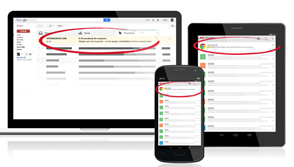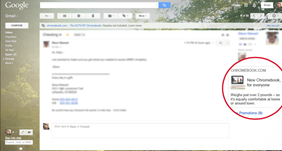Do you have troubles finding the right audience for your ad? Do you think that the classical targeting options aren’t detailed enough for your targeting idea? Gmail Sponsored Promotions is the solution for this problem.
What is Gmail Sponsored Promotions?
A Gmail Sponsored Promotion will appear as an ad email in the Promotions Tab or as a banner on the right side of your Gmail account:
 |
 |
Customers can see the ad when they click on one of the banners above.
How does it work?
Your audience sees one of your GSP ads which is called a “teaser”. The teaser ad is the first ad people see when there are in their Gmail inbox (Promotion Tab or right hand banners). This ad must ‘tease’ people to click on it. When they click on this teaser, the promotional ad appears, this is the “Expended ad”. With this promotional ad an advertiser can push a promo, a branding message, a contest, etc. You can import a text, a photo, a form, a video, a click- to call, an app-download, standard HTML of Dynamic Content. A lot of possibilities! This expanded ad must have a clear call-to-action for your audience.
After your target audiences saw the promotional ad, and clicked on it, they will be redirect to your website (or any URL you like).
What does it costs?
The GSP’s are Cost-Per-Click. This means that you only get charged when someone clicks on your ad. Every interaction (a share, a click to the website, a forward of the ad,..) that happens after this click is free.
How can you validate your design of your GSP?
Google created a page where you can validate if your creative is good to run as a GSP. You can find the link here: https://www.google.com/ads/gsp/creative/
What are the targeting options?
There are a lot of targeting criteria for GSP. While you are adapting your targeting, the GSP interface gives you estimation about the audience.
All those targeting criteria are classified into two categories:
- Demographics: Age, Gender, Language, Location and Device.
- User Attribution: Interests & Keywords, Jobs, Purchases and Domains.
This targeting criterion goes then more into details. First you have all the “classical” targeting including:
- Demographics: you can select age ranges, gender, language, locations (countries, regions,..) and the device that you want to target ( Desktop, Android, iOS or all of them).
- Interest and Keywords.
Then you have advanced targeting options only available in GSP:
- Job: Here you can target people based on their job. In the GSP interface Google will give you a list of possible jobs.
- Purchase: Here you have the possibility to target people that have recently purchased a product or booked a service. For example, if you are an e-commerce that sells pet toys or food for animals online, you can target people that already bought pet supplies in the past and attract them to your website with a special promo.
- Domains: With GSP you can target Domains. Not only your domains, but any domains. This way you can target your partners’ domains, or even those of your competitors.
All the targeting options of the User Attributions can also be used for exclusions. By default, all the attributions that you add, are OR attributions. This means that the people in your audience need to fulfill one of the conditions of your targeting. You can select the AND attributes, but then the people in your audience need to fulfill to all user attributes of your targeting.
Structure of creating a GSP
The creation of a GSP campaign differs from the creation of a standard AdWords Campaign. Although you need the same things (a campaign and an ad), there are no ad groups in GSP. Here are the steps you need to take:
- Add budget to your GSP account,
- Create all ads you would like to use in your campaign and request an approval,
- Create a campaign where you want you ads to run, with the targeting settings.
Performances
After testing the GSP ads for several months now, we see very promising results. As GSP is compared with a standard Display Campaign, we see that the performance is way better than a normal GDN campaign. We have a very high CTR (300% higher than the average Display Campaigns CTR for the same promo) with a very low cpc (divided by 2 vs. the regular GDN campaign). We don’t only see interaction with the website, but we also see that people of our targeting group forward our ad, or even that they save it to check it later.
A strong call-to-action combined with advanced targeting are definitely the key for those excellent results.
To conclude we have to admit the Gmail Sponsored Ads are a wonderful way to precisely reach your target audience. You can create a custom ad, with video, photo’s and text. You have a wide selection of metrics to target and because it is still a new feature, you don’t have a lot of competition.



